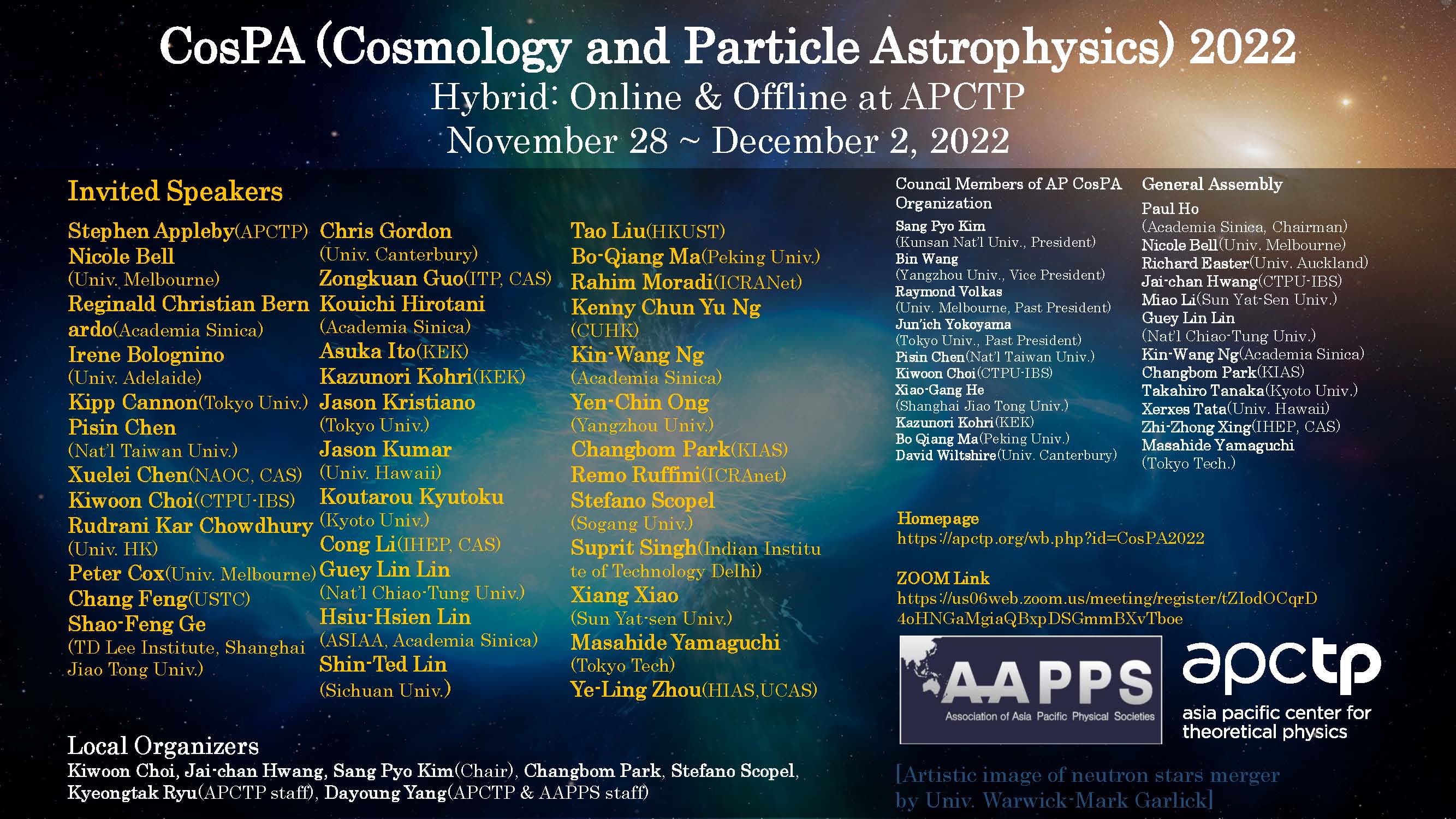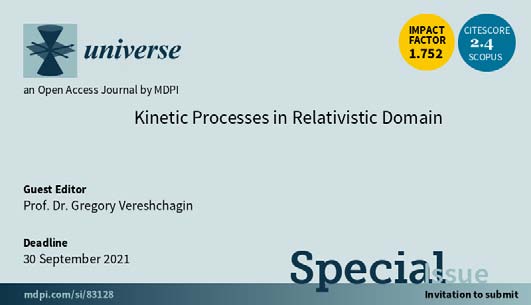

| Newsletter English December/January 2023 |

|

|



ICRANet Newsletter
2014 -
2015 -
2016
2017 - 2018 - 2019 2020 - 2021 2022 February/March - April/May/June - July/August/September - October/November - December/January 2023 2023
ICRANet Newsletter
December 2022 / January 2023
SUMMARY
1. Scientific highlights: N. Sahakyan, P. Giommi, P. Padovani, M. Petropoulou, D. Bégué, B. Boccardi, S. Gasparyan, A multimessenger study of the blazar PKS 0735+178: a new major neutrino source candidate, Monthly Notices of the Royal Astronomical Society, Volume 519, Issue 1 2. Publication of MG16 e-proceedings, January 25, 2023 3. ICRANet participation at the International Symposium on Cosmology and Particle Astrophysics in 2022 (CosPA 2022), November 27 - December 2, 2022, APCTP (South Korea) and online 4. 2nd Italian Knowledge leaders meeting, December 5, 2022, Milan (Italy) 5. Prof. Rahim Moradi awarded the Prize Lucio Colletti, December 7, 2022, Rome (Italy) 6. Special Issue Universe “Kinetic Processes in Relativistic Domain”, edited by Prof. Gregory Vereshchagin 7. Scientific visits to ICRANet 8. Recent publications
1. Scientific highlights: N. Sahakyan, P. Giommi, P. Padovani, M. Petropoulou, D. Bégué, B. Boccardi, S. Gasparyan, A multimessenger study of the blazar PKS 0735+178: a new major neutrino source candidate, Monthly Notices of the Royal Astronomical Society, Volume 519, Issue 1
The blazar PKS 0735+178 is possibly associated with multiple neutrino events observed by the IceCube, Baikal, Baksan, and KM3NeT neutrino telescopes. This remarkable combination of events and multi-wavelength coverage makes PKS 0735+178 one of the best candidate neutrino sources discovered so far. The multimessenger properties of PKS 0735+178 have been studied in a recent paper published in Monthly Notices of the Royal Astronomical Society coauthored by N. Sahakyan, P. Giommi, P. Padovani, M. Petropoulou, D. Bégué, B. Boccardi and S. Gasparyan.
The discovery of a flux of very high-energy (VHE; > 100 GeV) neutrinos of astrophysical origin by the IceCube South Pole observatory and the first reliable association of IceCube neutrinos with a cosmic source, the blazars TXS 0506+056, paved the way for the beginning of (extra-galactic) neutrino astronomy. Recently, several other possible associations between IceCube neutrinos and blazars have been observed, strengthening the connection between VHE neutrinos and blazars at varying levels of significance. Blazars, a rare type of powerful Active Galactic Nuclei (AGN) with a relativistic jet pointing at the Earth, are known to be efficient and powerful cosmic accelerators, and for this reason, have long been considered potential sources of astrophysical neutrinos.
Figure 1 shows the multi-wavelength light curve of PKS 0735+178 from 2008 to 2022, while figure 2 displays a composite multi-frequency light curve around the time of the neutrino arrival. The flux in all bands exhibits a similar behavior, with the largest flare since the launch of the Fermi satellite in 2008 occurring at the time of IceCube-211208A, marked on the figure by a red vertical dashed line. At the time of the arrival of the IceCube-211208A neutrino, PKS 0735+178 was undergoing the largest 𝛾-ray, X-ray and optical flare observed since 2008. This further strengthens the possible association between PKS 0735+178 and IceCube-211208A and PKS 0735+178 should be considered one of the best VHE neutrino source candidates detected so far.
Thanks to the very good multiwavelength coverage from the optical to the HE band during the IceCube-211208A event, the available data set is very constraining allowing to perform comprehensive modelling of the multiwavelength emission from PKS 0735+178. In particular, the spectral energy distribution of PKS 0735+178 was modeled within one-zone lepto-hadronic models considering both internal and external photon fields and estimate the expected accompanying neutrino flux. The code SOPRANO was used to simulate the electromagnetic and neutrino emissions from PKS0735+178. The code has been developed to study the time-dependent 𝛾-ray and neutrino emission from relativistic sources such as blazars and gamma-ray bursts, taking into account all relevant radiative processes. The most optimistic scenario invokes a jet with luminosity close to the Eddington value and the interactions of ∼ PeV protons with an external UV photon field. Broadband SED of PKS 0735+178 during the time of the arrival of IceCube-211208A modeled considering the presence of an external radiation field (broad line region photons) is shown in Figure 3. This scenario predicts ∼ 0.067 muon and antimuon neutrinos over the observed 3-week flare. The obtained results are consistent with the detection of one very-high-energy neutrino like IceCube-211208A.
2. Publication of MG16 e-proceedings, January 25, 2023

It is our great pleasure to inform you that the proceedings of the MG16 meeting, held online from July 5 to 10, 2021, have been just published by the World Scientific as open access document. Here is the link to the 4 Volumes (A, B, C and D) on the World Scientific website dedicated page: www.worldscientific.com/worldscibooks/10.1142/13149
These proceedings include about 400 papers resulting in 4880 pages of printed volumes covering virtually all topics of astrophysics, gravity and cosmology, traditionally discussed at MG meetings.
We recall that MG16 has been a record breaking meeting with over 1200 participants from more than 50 nations. The editors of these proceedings are Remo Ruffini and Gregory Vereshchagin.
3. ICRANet participation at the International Symposium on Cosmology and Particle Astrophysics in 2022 (CosPA 2022), November 27 - December 2, 2022, APCTP (South Korea) and online
From November 27 to December 2, 2022, Prof. Remo Ruffini (Director of ICRANet) and Prof. Rahim Moradi (ICRANet Faculty Professor), have been invited to present a lecture on the occasion of International Symposium on Cosmology and Particle Astrophysics in 2022 (CosPA 2022), held both at APCTP (South Korea) and online.
The CosPA is a series of conferences, initiated in Taiwan and organized in the Asia Pacific region annually as an activity of the Asia Pacific Organization of Cosmology and Particle Astrophysics (APCosPA). This edition took place after 2 years of postponement, due to the spreading Covid-19 pandemic. The main topics addressed during the conference have been astrophysics, particle physics, cosmology and gravitation.  On Wednesday, November 30, Prof. Ruffini presented a lecture titled“GRB-Supernova Association within the Binary-Driven Hypernova Model”. Here below the abstract: The association of supernova with GRBs was heralded by the Beppo SAX and the optical observation of SN1998bw associated with GRB980425. Since the beginning, the problem was to face the different conceptual origins of these components and their energetics. Today this field has been developed in the Binary driven Hypernova (BdHN model) and has grown as the most extended topic in relativistic astrophysics. The role of the progenitor CO core and a binary neutron star has recently become central in the BdHN model's development. In this work, the BdHN I, BdHN II, and BdHN III families, and the role of supernova, newborn neutron star, and companion NS (BH in BdHN I) are described in detail. On Thursday, December 1, Prof. Rahim Moradi presented a lecture titled“GRB 221009A: A type I BdHN of exceptional energetics”. Here below the abstract: GRB 221009A, the most intense and fluent GRB detected by Fermi GBM, presents a rare opportunity to test various GRB models. In this research, we examine the characteristics of GRB 221009A using the Binary Driven Hypernova (BdHN) model. GRB221009A categorized as a type I BdHN, originates from the collapse of a carbon-oxygen core (CO-core) in presence of a companion neutron star (NS). In this research we first examine the characteristics of the inner engine of this GRB which powers the GeV radiation observed by Fermi-LAT. We also demonstrate that the X-ray afterglow emission is powered by the release of rotational energy of the newborn neutron star evolving as a Maclaurin spheroid, starting from the bifurcation point of the Jacobi ellipsoid sequence. For the website of the meeting: indicocquest.sogang.ac.kr/event/19/
4. 2nd Italian Knowledge leaders meeting, Milan (Italy), December 5, 2022
On December 5, 2022, Prof. Remo Ruffini, Director of ICRANet, has been invited to participate to the 2nd Italian Knowledge Leaders meeting as one of the awarded Italian knowledge leaders.

This project, organized under the aegis of the Italian Ministry of tourism, aimed to start a path which brings together the support of the Italian Institutions and firms as well as the scientific and cultural competences of the most relevant "knowledge leaders" of our country. This meeting was attended by relevant representatives of the national and local Institutions, as well as by a delegation of the main ‘Italian Knowledge Leaders’, prominent members from international scientific and professional Institutions. This is the second event of a series of meetings, which will provide a nice occasion to organize networking activities, training courses and conferences aiming at improving the awareness of the scientific and cultural development at national and international level. The main goal of the project is to give the right recognition to these "intellectual leaders" as ambassadors of the Italian intellectual capital, involving them in the promotion of Italy as a "destination of knowledge" and encouraging the opinion leaders to be even more active at international level, in order to promote the scientific and cultural knowledge of our country.
5. Prof. Rahim Moradi awarded the Prize Lucio Colletti, Rome (Italy), December 7, 2022
It is our pleasure to announce that on December 7, 2022 Prof. Rahim Moradi, ICRANet Faculty Professor, has been awarded the Prize “Lucio Colletti” by the Lucio Colletti Foundation. The ceremony took place in the “Sala Laudatosì” of the Senatorial Palace at Camipoglio, the seat of Rome Municipality.
In the 2022 edition, the prize has been also attributed to Marco Taradash (politician), Lorenzo Infantino (philosopher), DianoraTinti (writer), Alessandra Giovannoni (painter), Giovanna Botteri (journalist), GiseldaVagnoni (journalist), Valerio Rossi Albertini (physicist), Silvio Perrella (writer) and Antonio Bonfilio (musicologist). Prof. Moradi was very grateful to receive this important recognition for his research and thanked all the organization for its kindness and regard.
6. Special Issue Universe “Kinetic Processes in Relativistic Domain”, edited by Prof. Gregory Vereshchagin

The journal Universe has published in 2022 a Special Issue titled “Kinetic processes in relativistic domain”, edited by Prof. Gregory Vereshchagin (ICRANet Faculty Professor). The goal of this Special Issue is to cover the recent developments in kinetic theory, with particular attention to relativistic plasma, neutrino transport, self-gravitating systems and dark matter, radiative transfer in relativistic flows and other new and emergent topics in kinetic theory. The contributions to this issue include:
All papers are published in open access format and can be downloaded from the Universe website: www.mdpi.com/journal/universe/special_issues/KPRD
7. Scientific visits to ICRANet
• Mikalai Prakapenia (ICRANet-Minsk and Belarusian State University), December 5 – 16, 2022
• Shurui Zhang (University of Science and Technology of China), December 15, 2022 – ongoing • Prof. Seyed Mohammad Taghi Mirtorabi (Alzahra University - Iran), January 26, 2023 - ongoing During their visit, those scientists had an opportunity to discuss their scientific research and to have fruitful exchange of ideas with other researchers from ICRANet and from different parts of the world.
8. Recent publications
Shesheng Xue, Massive particle pair production and oscillation in Friedman Universe: its effect on inflation, to be published in The European Physical Journal C.
We study the classical Friedman equations for the time-varying cosmological term Λ~ and Hubble function H, together with quantised field equations for the production of massive M≫H particles, namely, the Λ~CDM scenario of dark energy and matter interactions. Classical slow components O(H−1) are separated from quantum fast components O(M−1). The former obeys the Friedman equations, and the latter obeys a set of nonlinear differential equations. Numerically solving equations for quantum fast components, we find the production and oscillation of massive particle-antiparticle pairs in microscopic time scale O(M−1). Their density and pressure averages over microscopic time do not vanish. It implies the formation of a massive pair plasma state in macroscopic time scale O(H−1), whose effective density and pressure contribute to the Friedman equations. Considering the inflation driven by the time-varying cosmological term and slowed down by the massive pair plasma state, we obtain the relation of spectral index and tensor-to-scalar ratio in agreement with recent observations. We discuss the singularity-free pre-inflation, the CMB large-scale anomaly, and dark-matter density perturbations imprinting on power spectra.
DOI: https://doi.org/10.1140/epjc/s10052-023-11195-6 M. F. Sousa, J. G. Coelho, J. C. N. de Araujo, S. O. Kepler and J. A. Rueda, The Double White Dwarf Merger Progenitors of SDSS J2211+1136 and ZTF J1901+1458, published on December 9, 2022 in The Astrophysical Journal, Volume 941, Number 1.
Double white dwarf (DWD) mergers are possibly the leading formation channel of massive, rapidly rotating, high-field magnetic white dwarfs (HFMWDs). However, a direct link connecting a DWD merger to any observed HFMWD is still missing. We here show that the HFMWDs SDSS J221141.80+113604.4 (hereafter J2211+1136) and ZTF J190132.9+145808.7 (hereafter J1901+1458) might be DWD merger products. J2211+1136 is a 1.27 M⊙ white dwarf (WD) with a rotation period of 70.32 s and a surface magnetic field of 15 MG. J1901+1458 is a 1.327–1.365 M⊙ WD with a rotation period of 416.20 s, and a surface magnetic field in the range 600–900 MG. With the assumption of single-star evolution and the currently measured WD masses and surface temperatures, the cooling ages of J2211+1136 and J1901+1458 are, respectively, 2.61–2.85 Gyr and 10–100 Myr. We hypothesize that these WDs are DWD merger products and compute the evolution of the postmerged configuration formed by a central WD surrounded by a disk. We show that the postmerger system evolves through three phases depending on whether accretion, mass ejection (propeller), or magnetic braking dominates the torque onto the central WD. We calculate the time the WD spends in each of these phases and obtain the accretion rate and disk mass for which the WD rotational age, i.e., the total time elapsed since the merger to the instant where the WD central remnant reaches the current measured rotation period, agrees with the estimated WD cooling age. We infer the mass values of the primary and secondary WD components of the DWD merger that lead to a postmerger evolution consistent with the observations.
DOI: https://doi.org/10.3847/1538-4357/aca015 Liang Li, Standard GRB Spectral Models "Misused"?, published on December 9, 2022 in the Astrophysical Journal, Volume 941, Number 1.
The standard model characterizing the gamma-ray burst (GRB) spectrum invokes a four-parameter empirical function, the so-called the BAND model. An alternative model named cutoff power law (COMP) implements a power law with an exponential cutoff. These functions achieve almost equally good fits on observed spectra, and are adopted in nearly all of the GRB literature. Here, we reanalyze the sample defined in Li et al. (39 bursts including 944 spectra). We classify the spectra by two methods: (1) checking their corner–corner plots of the posteriors to determine well-constrained β (BAND-better) and unconstrained β (COMP-better) categories; and (2) defining the four groups by difference of the deviance information criterion (DIC). We find inconsistent peaks of the parameter distributions between the BAND-better spectra (α = −0.64 ± 0.28 and log10 (Ep) = log10 (191) ± 0.41) and the COMP-better spectra (α = −0.96 ± 0.33 and log10 (Ep) = log10 (249) ± 0.40). With the statistically preferred model and vice versa the misused model defined based on DIC statistics, we also find that the fitted parameters obtained by the misused model (COMP) significantly deviate from those obtained by the statistically preferred model (BAND). This means that if a spectrum is statistically preferred, described as the BAND, applying COMP to derive the spectral parameters will prominently deviate from their intrinsic shape, therefore affecting the physical interpretation. Our analysis indicates that the better or statistically preferred model should be duly examined during GRB spectral analysis. In addition, the β distribution exhibits a bimodal structure containing the BAND-better and COMP-better spectra, respectively, implying that BAND and COMP both may have physical origin.
DOI: https://doi.org/10.3847/1538-4357/ac3d89 N. Sahakyan, P. Giommi, P. Padovani, M. Petropoulou, D. Bégué, B. Boccardi, S. Gasparyan, A multimessenger study of the blazar PKS 0735+178: a new major neutrino source candidate, Monthly Notices of the Royal Astronomical Society, Volume 519, Issue 1.
The blazar PKS 0735+178 is possibly associated with multiple neutrino events observed by the IceCube, Baikal, Baksan, and KM3NeT neutrino telescopes while it was flaring in the γ-ray, X-ray, ultraviolet, and optical bands. We present a detailed study of this peculiar blazar to investigate the temporal and spectral changes in the multiwavelength emission when the neutrino events were observed. The analysis of Swift-XRT snapshots reveal a flux variability of more than a factor 2 in about 5 × 103 s during the observation on 2021 December 17. In the γ-ray band, the source was in its historical highest flux level at the time of the arrival of the neutrinos. The observational comparison between PKS 0735+178 and other neutrino source candidates, such as TXS 0506+056, PKS 1424+240, and GB6 J1542+6129, shows that all these sources share similar spectral energy distributions, very high radio and γ-ray powers, and parsec scale jet properties. Moreover, we present strong supporting evidence for PKS 0735+178 to be, like all the others, a masquerading BL Lac. We perform comprehensive modelling of the multiwavelength emission from PKS 0735+178 within one-zone lepto-hadronic models considering both internal and external photon fields and estimate the expected accompanying neutrino flux. The most optimistic scenario invokes a jet with luminosity close to the Eddington value and the interactions of ∼PeV protons with an external UV photon field. This scenario predicts ∼0.067 muon and anti-muon neutrinos over the observed 3-week flare. Our results are consistent with the detection of one very high-energy neutrino like IceCube-211208A.
DOI: https://doi.org/10.1093/mnras/stac3607 N. Sahakyan, V. Vardanyan, M. Khachatryan, Gradient boosting decision trees classification of blazars of uncertain type in the fourth Fermi-LAT catalogue, to be published on Monthly Notices of the Royal Astronomical Society, Volume 519, Issue 2.The deepest all-sky survey available in the γ-ray band – the last release of the Fermi-LAT catalogue (4FGL-DR3) based on the data accumulated in 12 years contains more than 6600 sources. The largest population among the sources is blazar subclass – 3743, 60.1 per cent of which are classified as BL Lacertae objects (BL Lacs) or Flat Spectrum Radio Quasars (FSRQs), while the rest are listed as blazar candidates of uncertain type (BCU) as their firm optical classification is lacking. The goal of this study is to classify BCUs using different machine learning algorithms, which are trained on the spectral and temporal properties of already classified BL Lacs and FSRQs. Artificial Neural Networks, XGBOOST, and LIGHTGBM algorithms are employed to construct predictive models for BCU classification. Using 18 input parameters of 2219 BL Lacs and FSRQs, we train (80 per cent of the sample) and test (20 per cent) these algorithms and find that LIGHTGBM model, state-of-the-art classification algorithm based on gradient boosting decision trees, provides the highest performance. Based on our best model, we classify 825 BCUs as BL Lac candidates and 405 as FSRQ candidates, however, 190 remain without a clear prediction, but the percentage of BCUs in 4FGL is reduced to 5.1 per cent. The γ-ray photon index, synchrotron peak frequency, and high-energy peak frequency of a large sample are used to investigate the relationship between FSRQs and BL Lacs (LBLs, IBLs, and HBLs).DOI: https://doi.org/10.1093/mnras/stac3701 MAGIC collaboration, Gamma-ray observations of MAXI J1820+070 during the 2018 outburst, published on December 2022 in Monthly Notices of the Royal Astronomical Society, Volume 517, Issue 4.MAXI J1820+070 is a low-mass X-ray binary with a black hole (BH) as a compact object. This binary underwent an exceptionally bright X-ray outburst from 2018 March to October, showing evidence of a non-thermal particle population through its radio emission during this whole period. The combined results of 59.5 h of observations of the MAXI J1820+070 outburst with the H.E.S.S., MAGIC and VERITAS experiments at energies above 200 GeV are presented, together with Fermi-LAT data between 0.1 and 500 GeV, and multiwavelength observations from radio to X-rays. Gamma-ray emission is not detected from MAXI J1820+070, but the obtained upper limits and the multiwavelength data allow us to put meaningful constraints on the source properties under reasonable assumptions regarding the non-thermal particle population and the jet synchrotron spectrum. In particular, it is possible to show that, if a high-energy (HE) gamma-ray emitting region is present during the hard state of the source, its predicted flux should be at most a factor of 20 below the obtained Fermi-LAT upper limits, and closer to them for magnetic fields significantly below equipartition. During the state transitions, under the plausible assumption that electrons are accelerated up to ∼500 GeV, the multiwavelength data and the gamma-ray upper limits lead consistently to the conclusion that a potential HE and very-HE gamma-ray emitting region should be located at a distance from the BH ranging between 1011 and 1013 cm. Similar outbursts from low-mass X-ray binaries might be detectable in the near future with upcoming instruments such as CTA.DOI: https://doi.org/10.1093/mnras/stac2686 MAGIC collaboration, Search for Gamma-ray Spectral Lines from Dark Matter Annihilation up to 100 TeV towards the Galactic Center with MAGIC, accepted for publication in Phys. Rev. Letters.Line-like features in TeV γ-rays constitute a ''smoking gun'' for TeV-scale particle dark matter and new physics. Probing the Galactic Center region with ground-based Cherenkov telescopes enables the search for TeV spectral features in immediate association with a dense dark matter reservoir at a sensitivity out of reach for satellite γ-ray detectors, and direct detection and collider experiments. We report on 223 hours of observations of the Galactic Center region with the MAGIC stereoscopic telescope system reaching γ-ray energies up to 100 TeV. We improved the sensitivity to spectral lines at high energies using large-zenith-angle observations and a novel background modeling method within a maximum-likelihood analysis in the energy domain. No line-like spectral feature is found in our analysis. Therefore, we constrain the cross section for dark matter annihilation into two photons to ⟨σv⟩ ≲ 5×10−28cm3s−1 at 1 TeV and ⟨σv⟩ ≲ 1×10−25cm3s−1 at 100 TeV, achieving the best limits to date for a dark matter mass above 20 TeV and a cuspy dark matter profile at the Galactic Center. Finally, we use the derived limits for both cuspy and cored dark matter profiles to constrain supersymmetric wino models.DOI: https://doi.org/10.48550/arXiv.2212.10527 S. H. Hendi, Kh. Jafarzade, and B. EslamPanah, Black holes in dRGT massive gravity with the signature of EHT observations of M87*, accepted for publication in Journal of Cosmology and Astroparticle Physics.The recent Event Horizon Telescope (EHT) observations of the M87* have led to a surge of interest in studying the shadow of black holes. Besides, investigation of time evolution and lifetime of black holes helps us to veto/restrict some theoretical models in gravitating systems. Motivated by such exciting properties, we study optical features of black holes, such as the shadow geometrical shape and the energy emission rate in modified gravity. We consider a charged AdS black hole in dRGT massive gravity and look for criteria to restrict the free parameters of the theory. The main goal of this paper is to compare the shadow of the mentioned black hole in a rotating case with the EHT data to obtain the allowed regions of the model parameters. Therefore, we employ the Newman-Janis algorithm to build the rotating counterpart of static solution in dRGT massive gravity. We also calculate the energy emission rate for the rotating case and discuss how the rotation factor and other parameters affect the emission of particles around the black holes. |
|||||||
|
||






